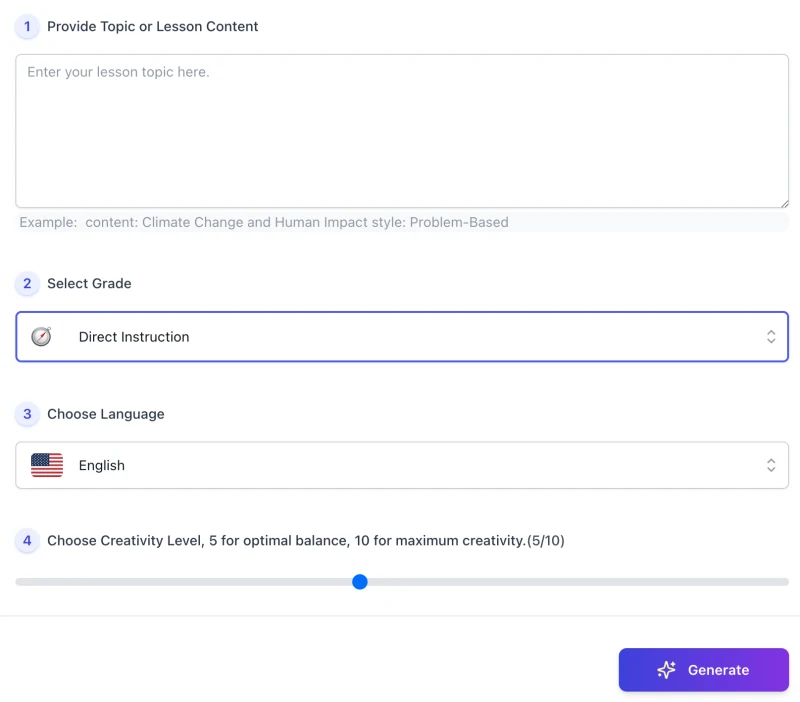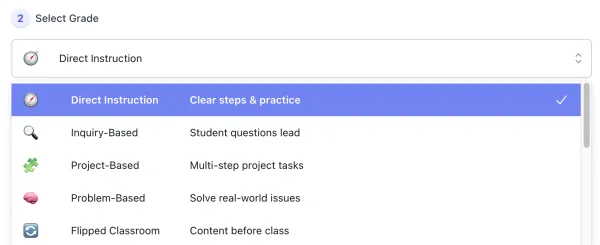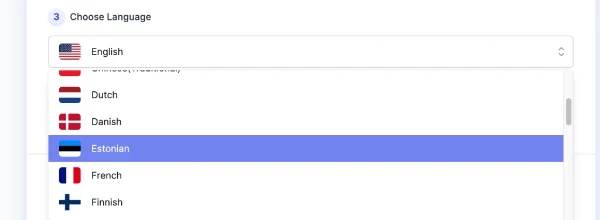This is the AIFreeBox AI Lesson Planner online tool page — a teaching assistant for educators. It helps teachers quickly draft a structured, practical lesson plan with objectives, activities, and assessments.
On this page, you’ll find the tool’s capabilities, use cases, a usage guide, tips, as well as its limitations, common issues, and FAQs — all focused on helping teachers start faster, save time, and keep full control over lesson design.
What Can AIFreeBox AI Lesson Planner Do?
The AIFreeBox AI Lesson Planner is powered by transformer-based large language models, fine-tuned for education. It turns a lesson topic into a clear, structured draft within seconds. This is not a factory replacing teachers, but a planning assistant that speeds up the first draft while leaving all decisions to educators.
At its core, the tool provides a Objectives → Activities → Assessment → Closure framework, enriched with 12 teaching styles and support for 33 languages. It builds the lesson skeleton — goals, materials, activities, and evaluation ideas — while adding creative options shaped by the chosen style.
The collaboration is simple: AI drafts, teachers refine. AI reduces repetitive formatting and activity listing; teachers review, align with curriculum standards, and adapt to local needs. This ensures lesson plans remain both efficiently structured and teacher-centered.
AIFreeBox Lesson Planner vs. “Generic Lesson Plan Template”
Not all AI tools for teachers work the same way. The comparison below highlights how the AIFreeBox AI Lesson Planner focuses on structured support and collaboration,
while generic “auto-plan generators” often aim to replace teacher input entirely.
|
✅ AIFreeBox AI Lesson Planner |
⚠️ Generic Lesson Plan Template |
| 🎯 Purpose |
Acts as an assistant — provides a clear draft that teachers refine and adapt. |
Attempts to replace teacher judgment; little room for customization. |
| 📝 Output |
Delivers a structured framework: Objectives → Activities → Assessment → Closure, easy to follow in class. |
Produces long text blocks with weak structure, often impractical for teaching. |
| 🎨 Styles |
Offers 12 distinct teaching styles and supports 33 languages, adaptable to diverse classrooms. |
One-size-fits-all, no style variation or multilingual support. |
| 🤝 Collaboration |
Encourages human–AI teamwork: AI drafts ideas, teachers align with standards and local needs. |
Leaves the teacher out of the process, presenting output as “final.” |
| ⚡ Efficiency |
Reduces repetitive tasks, suggests creative activities, saves time without removing teacher control. |
Initial output often requires rewriting or heavy editing to be usable. |
| ✅ Reliability |
Supports standards alignment by suggesting skills and tags, leaving final verification to the teacher. |
Claims full alignment but lacks accuracy or context, risking compliance issues. |
Recommend Use Cases and Benefits
This table summarizes common scenarios, the issues addressed, and who benefits.
| 📌 Use Case |
Problem It Solves |
Who Benefits |
| ⏱️ Fast Drafting |
Cuts long hours of lesson preparation |
Teachers under heavy workload |
| 📑 Structured Plans |
Avoids missing key parts of a lesson |
New or busy educators needing consistency |
| 🎨 Style Variety |
Supports different teaching approaches |
Educators testing new methods |
| 🌍 Multilingual Lessons |
Produces drafts in 33 languages |
International schools & bilingual classes |
| 👩🏫 Teacher-Led |
Keeps control and final judgment with educators |
Teachers aligning with standards & policies |
| 💡 Fresh Ideas |
Offers new activities and assessments |
Teachers needing classroom inspiration |
| 📊 Flexible Coverage |
Adapts to any subject or grade level |
Schools and curriculum teams |
How to Make a Lesson Plan with AIFreeBox AI:
Step-by-Step Guide

The following steps explain how to use the AI Lesson Planner interface to generate and refine lesson plans.
Step 1: Provide Topic or Lesson Content
Enter a clear subject or concept you want to teach. For example: “Climate Change and Human Impact”.
Step 2: Select a Teaching Style

Choose one of the 12 available teaching styles (e.g., Direct Instruction, Project-Based, Inquiry-Based) to shape the structure of the lesson plan.
Step 3: Choose Output Language

Select one of the 33 supported languages. The lesson plan will be generated in your chosen language.
Step 4: Adjust Creativity Level
Use the slider to balance structure and originality (5 = balanced, 10 = highly creative).
Step 5: Generate the Lesson Plan
Click the Generate button. The tool will create a draft including objectives, activities, assessments, and closure.
Step 6: Download, Copy, or Report Bug ( Real Human Support )

– Use Download to save the lesson plan as a file.
– Use Copy to quickly paste the content elsewhere.
– Use Report Bug to notify our support team if something doesn’t work.
Reports are reviewed by real staff who respond to ensure reliability and improve your experience.
Remember: Each generated draft provides the full lesson skeleton — objectives, materials, activities, assessment, and extension. Based on the chosen teaching style, it suggests activity types and creative ideas, reducing repetitive formatting work. Teachers review the output against curriculum standards, adapt it to their students and context, and decide the final flow, classroom management, and differentiation strategies.
Practical Tips for Getting a Lesson Plan Template
These suggestions can help you guide the tool to produce useful drafts and then adapt them for real classroom use.
How to Get Better Lesson Plan Drafts
- 🖊️ Be specific with your topic: Instead of “Math,” try “Fractions in Everyday Life.”
- 🎨 Match your style to your goal: Use Project-Based for teamwork, Direct Instruction for step-by-step lessons.
- 🌍 Choose the right language: Select from 33 supported languages to fit your class.
- ⚖️ Set creativity wisely: Use mid-level for balance; higher levels for more varied ideas.
How to Refine and Make It Yours
- 📚 Check with curriculum: Make sure objectives match your local or national standards.
- 👩🎓 Adapt for your students: Adjust activities for class size, learning levels, or language support needs.
- 🏫 Align with school context: Ensure the plan fits timing, policies, and available resources.
- 🛠️ Add your own touch: Insert examples, stories, or materials familiar to your students.
Lesson Plan Example: From Draft to Classroom
This section shows how teachers use the planner in practice — from input to AI draft, teacher refinements, and the final plan.
Case 1 · Science (Project-Based)
- 🧩 Inputs: content = Climate Change and Human Impact; user_style = Project-Based; language = English
- ⚙️ Context: Mixed-ability class, one 60-minute period + optional extension
AI Draft (Key Excerpts)
- 🎯 Objectives: Explain greenhouse effect; analyze local impact; propose mitigation ideas.
- 📋 Framework: Objectives → Activities → Assessment → Closure (style-driven).
- 🛠️ Activities:
- Milestone 1: Research mini-sources; evidence log.
- Milestone 2: Prototype “Reduce-CO₂ at school” poster or infographic.
- Milestone 3: Peer review using quick checklist.
- 🧪 Assessment: 4-level rubric (Accuracy, Evidence, Design, Feasibility).
- 🔚 Closure: Reflection ticket: “One change I will try this week.”
Teacher Refinements (Localization)
- 📚 Align with local standards: adds tags for “Argumentation” and “Modeling” (codes verified by teacher).
- 👩🎓 Differentiation: sentence starters for ELL; extension task for advanced students (data analysis).
- 🏫 School context: replaces digital poster with printable template (low-device classroom).
- ⏱️ Timing: splits into 2 × 40-minute blocks to fit timetable.
Final Snapshot
- ✅ Clear PBL flow with milestones and peer review.
- 🧭 Rubric trimmed to one line per criterion for quick use.
- 📝 Handout pack (printable evidence log + reflection ticket).
Outcome: Teacher reports reduced planning time (≈30–40 minutes saved) and better student engagement due to the milestone structure.
Case 2 · Math (Direct Instruction)
- 🧩 Inputs: content = Introduction to Fractions; user_style = Direct Instruction; language = English
- ⚙️ Context: 45-minute lesson; large class size
AI Draft (Key Excerpts)
- 🧭 I Do: Model fraction-as-part-of-a-whole with real objects.
- 👥 We Do: Guided practice with mini-whiteboards; quick checks.
- 🧑🏫 You Do: Independent practice (differentiated A/B sets).
- 🚪 Exit Ticket: “Shade 3/4 of the shape; explain why.”
Teacher Refinements (Localization)
- 📚 Uses the school workbook page for examples to match homework.
- 📏 Adds manipulatives (paper circles) for concrete–representational–abstract progression.
- 👂 Adds pair-check protocol to manage the large class.
Final Snapshot
- ✅ Clear I/We/You Do sequence with timed segments.
- 🔁 Quick-check routine documented to streamline transitions.
Outcome: Faster transitions and fewer off-task moments; teacher keeps full control of pacing and checks for understanding.
Note: In both cases, the planner supplies the full lesson skeleton (objectives, materials, activities, assessment, extension).
Teachers verify standards, adapt for students and policies, and finalize the flow.
The tool supports 12 teaching styles and 33 languages.
Teaching Styles Available in the Planner
The planner offers 12 teaching styles. Each style shapes how objectives, activities, and assessments are suggested. Teachers choose the one that fits their classroom goals best.
- 📖 Direct Instruction: Step-by-step teaching with clear explanations and practice.
- 🔍 Inquiry-Based: Students explore questions and investigate ideas actively.
- 🧩 Project-Based: Learning through projects that connect to real-world contexts.
- 🤝 Collaborative Learning: Group work focused on discussion and teamwork.
- 🎮 Game-Based: Learning through structured play, challenges, or simulations.
- 🎭 Role-Play / Simulation: Students act out scenarios to deepen understanding.
- 💡 Creative Expression: Arts, design, or storytelling used to reinforce content.
- 🧠 Cognitive Skills Focus: Emphasis on problem-solving and critical thinking.
- 🌍 Cross-Curricular: Combines subjects (e.g., math + science, history + art).
- 👩🏫 Flipped Classroom: Content reviewed at home; class time used for activities.
- 📝 Assessment-Driven: Activities designed to prepare for tests or performance checks.
- 📚 Discussion-Based: Focused on dialogue, debate, and reflective conversation.
Limitations and Troubleshooting
No tool is perfect. Here are common limitations and possible solutions when using the AI Lesson Planner.
| ⚠️ Limitation |
💡 Solution |
| May not fully match local curriculum standards |
Teachers should review and align objectives with official guidelines |
| Activities can feel too generic in some drafts |
Add examples from your own classroom or adapt with local materials |
| Assessment rubrics are simplified |
Refine criteria to fit your school’s grading policies |
| Limited handling of special needs or differentiation |
Modify tasks for diverse learners and add accommodations where needed |
| Output depends on input quality |
Be specific with topic and style; vague inputs lead to weaker drafts |
| Occasional errors or technical issues |
Use the Report Bug feature; our team reviews and responds promptly |
FAQs
Can the planner replace a teacher’s professional judgment?
No. The tool generates a structured draft, but teachers must adapt and finalize it based on curriculum, class needs, and school context.
How accurate are the learning objectives?
Objectives are suggested from general patterns. Teachers should review and align them with local or national standards before use.
Will the tool cover every subject and grade level?
It can draft plans for a wide range of subjects and ages, but some specialized topics may need extra teacher input and adaptation.
How can I make the generated activities more relevant?
Be specific in your input. Adding details like lesson focus, class size, or preferred teaching method improves relevance.
Does it support differentiated instruction?
The draft may not fully address special needs or diverse learning profiles. Teachers should add accommodations and extensions as needed.
What if I find errors or technical issues?
Use the Report Bug option. Reports are reviewed by our support team, who provide fixes and improvements.
Is my input stored or shared publicly?
No. Your inputs are not used for public display and are not saved beyond the session. This ensures privacy and classroom safety.
Creator’s Note
I created the AI Lesson Planner with a simple idea in mind: teachers should not spend endless hours struggling with formatting and repetitive drafting.
The tool is here to provide a structured starting point — objectives, activities, and assessments in one framework — so that teachers can focus on what truly matters: their students.
This is not an automatic factory for lesson plans. It does not replace professional judgment, local standards, or the creativity of a teacher.
Instead, it acts as a partner: AI provides the skeleton, teachers bring context, care, and expertise to make it real in the classroom.
Every draft generated is only the first step. The teacher’s role remains central — checking alignment with curriculum, adapting for classroom diversity, and ensuring lessons fit school policies and student needs.
In this way, the planner strengthens, rather than replaces, the human side of teaching.
— Matt Liu
2025-10-17



